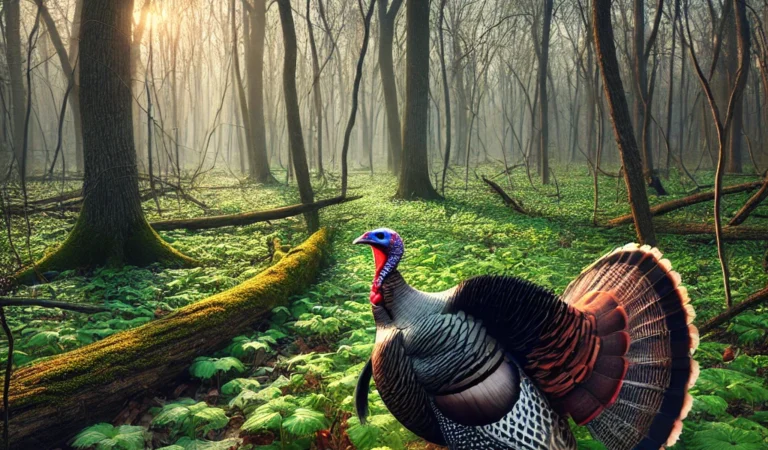Turkey Hunting Texas: Powerful Guide for 2024
Hey there, fellow Texas hunters! It’s Jimmy from deep in the heart of Hill Country. I’ve been chasing gobblers across our great country for over 20 years now, and let me tell you, there’s nothing quite like turkey hunting Texas.
The Texas Hill Country is a prime location for turkey hunting, particularly for Rio Grande turkeys, thanks to its abundant wildlife habitat, live oak trees, and creek access.
Today, I want to share some of my hard-earned wisdom with y’all, especially those just starting this amazing sport. Let’s discuss turkey hunting in Texas!

- Turkey Time: Know Your Seasons
First, let’s talk about when you can hunt these crafty birds. In Texas, we’ve got two main seasons:
Spring Season: This is the big one, folks! The spring turkey season usually runs from late March to early May, depending on which part of the state you’re in. This is when the toms are out looking for love, making them more responsive to our calls.
Fall Season: Some counties also have a fall season, usually from November to early January. It’s a different ball game than spring, as the turkeys are in their winter flocks.
Always double-check the dates with Texas Parks and Wildlife before you head out. They can change from year to year, and nobody wants to get in trouble for hunting out of season!
Where the Turkeys Roam
Now, where can you find these elusive birds? Texas is a big place, and turkeys don’t live everywhere. Here are some top spots:
Public Lands: We’ve got some great Wildlife Management Areas (WMAs) that allow turkey hunting. Places like Caddo National Grasslands or Somerville WMA can be gold mines if you know what you’re doing.
Private Lands: If you’re lucky enough to access private land or can afford a lease, you might have better luck. Just make sure you’ve got all the right permissions!
Top Counties: In my experience, some of the best turkey hunting happens in counties like Kerr, Gillespie, and Mason. The Hill Country is turkey heaven!
East Texas: Certain East Texas counties offer unique hunting opportunities and specific regulations for Eastern wild turkeys. The diverse environments, such as the Piney Woods, impact hunting strategies, and the successful population reintroduction have made this region a notable spot for turkey hunting.
Gearing Up Texas-Style
You don’t need a ton of fancy gear to get started, but here are the basics:
Camo: In Texas, everything from piney woods to scrub brush. Make sure your camo matches where you’re hunting.
Calls: A good box call is easy to use for beginners. Try a slate call or even a mouth call as you get better.
Shotgun: A 12-gauge is perfect, but a 20-gauge works, too, if you’re more comfortable with it. Just make sure you’re using the right shells for turkey hunting.
Turkey Hunts Tricks of the Trade
Here’s where the rubber meets the road. To bag a turkey in Texas, you’ve got to think like one:
Scout it out: Look for signs like tracks, droppings, or feathers. The more you know where the turkeys hang out, the better your chances.
Call them in: To hunt turkey, start soft and get louder. But remember, sometimes less is more. I’ve seen many a newbie scare off a tom by overcalling.
Set up smart: Find a good spot with your back against a tree and ensure a clear shooting lane. Patience is key here, folks.
Tricks of the Trade:
Hunting roosting turkeys at any time without proper department authorization is unlawful. Make sure to tag your harvested turkeys appropriately.
Safety First, Always
I can’t stress this enough – safety is the most important thing out there. Always identify your target before you shoot, and be aware of what’s beyond it. And don’t forget about the Texas heat!
Bring plenty of water and watch out for snakes. When hunting wild turkeys in Texas, you must always be aware of your surroundings. Additionally, it is crucial to tag and track a harvested turkey according to legal requirements.
Texas: A Premier Destination for Turkey Hunting
Texas’s varied terrain, from rolling plains to dense forests and river valleys, offers ideal turkey habitats. Hunters are drawn to the challenge of the Eastern and Rio Grande turkeys, known for their keen senses and elusiveness. The Eastern wild turkey, in particular, presents unique challenges compared to other subspecies, making it a sought-after target for experienced hunters.
Success in the Texas turkey season demands skill, patience, and a deep understanding of turkey behavior and terrain navigation. While Rio Grande turkeys dominate the state, eastern wild turkeys can also be found predominantly in eastern Texas regions. The successful reintroduction of eastern turkeys in certain areas has added to the diversity of hunting experiences, with varying habitats and conditions influencing turkey hunting across different landscapes.
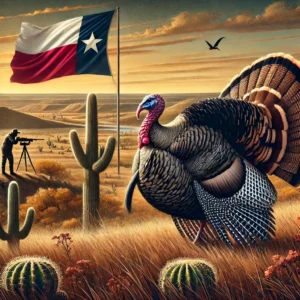
Regulations and Guidelines in Texas Hunting
The TPWD upholds conservation and sustainable wildlife management through strict regulations. Hunters must familiarize themselves with these rules, covering hunting seasons, bag limits, licensing, and safety measures. A valid Texas hunting license is essential for participating in turkey hunting seasons, which vary from spring to fall.
Adherence to these guidelines ensures the conservation of turkey populations for future generations and upholds ethical hunting practices.
Wild Turkey Species in Texas: Diversity and Beauty
Texas boasts two primary turkey species: the Eastern turkey and the Rio Grande turkey. Each has unique characteristics and preferred habitats, and understanding these differences is crucial for a successful hunt. The Eastern wild turkey, in particular, presents unique challenges due to its specific habitat preferences and behaviors.
While Rio Grande turkeys dominate much of Texas, eastern wild turkeys can be found predominantly in the eastern regions of the state. The successful reintroduction of eastern turkeys in certain areas has provided hunters with new opportunities. These birds thrive in diverse habitats and terrains, making hunting them a distinct experience compared to the more common Rio Grande turkeys.
Eastern Turkey: The Forest’s Majestic Emblem
Now, if you’re into spring turkey hunting in the eastern part of our state, you’ll likely encounter the Eastern wild turkey.
These birds, with their dark, iridescent plumage, thrive in the dense woodlands of Eastern Texas. The successful reintroduction of Eastern wild turkeys in East Texas has bolstered their populations in areas with favorable hatch conditions.
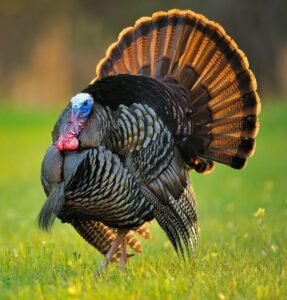
Let me tell you, hunting these birds often requires extra patience and skill due to their preference for dense cover. When I’m after Easterns, I find myself moving slower, listening harder, and putting my camouflage skills to the test. It’s a whole different ballgame, but man, is it rewarding!
Rio Grande Turkey: The Icon of Texas's Southwest
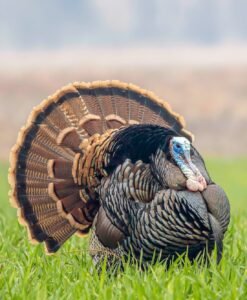
When it comes to Rio Grande turkey hunts, you’re in for a real treat. The lighter-feathered Rio Grande turkey is at home in the open habitats of Texas’s Hill Country and Central Plains. Their adaptability to varied landscapes makes them a prevalent and challenging target. These birds thrive in the mix of open grasslands and scattered brush that’s so common in central and western Texas. If you’re looking to bag a Rio, focus your hunts on these areas – you won’t be disappointed!
Turkey Habitats Across Texas
Hill Country: Rolling Hills and Rio Grande Turkeys
The Hill Country, with its abundant Rio Grande turkeys and picturesque landscapes, provides a perfect setting for hunters looking for diverse terrain and plentiful game.
Pineywoods: Dense Forests Home to Eastern Turkeys
The Pineywoods region offers a challenging hunt amidst towering pines and hardwoods, where Eastern turkeys roost and forage.
Central Texas Plains: A Blend of Fields and Woods
Central Texas Plains, with its open and wooded areas, attracts both Eastern and Rio Grande turkeys, offering hunters varied hunting experiences.
Understanding Turkey’s Behavior and Biology
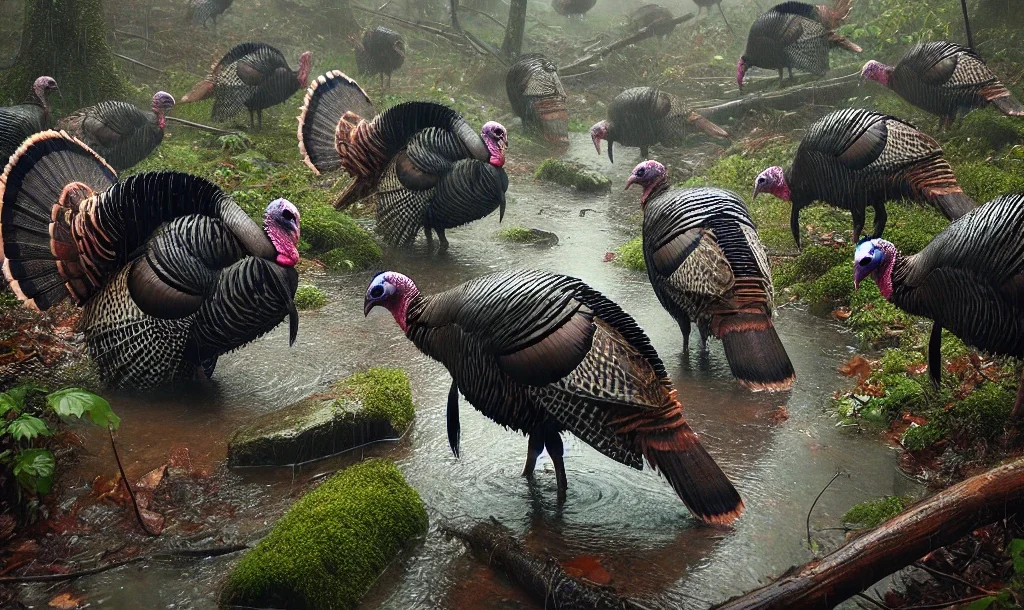
Breeding Behaviors in Spring
Spring in Texas marks the height of turkey breeding behavior, with toms displaying and vying for hens’ attention. Recognizing these behaviors can significantly benefit hunters.
Roosting and Nesting Habits
Turkeys roost in trees for safety and nest on the ground in concealed spots. Hunters can use this knowledge to locate turkeys during the season.
Vocalization Insights
Gobbling, yelping, and purring are key turkey vocalizations. Hunters can mimic these sounds to attract turkeys during the hunt.
Wrapping Up Turkey Hunting Texas
Turkey hunting in Texas is more than just a sport – it’s a way to connect with nature and carry on a proud tradition. Whether you’re a seasoned pro or a first-timer, there’s always something new to learn.
So get out there, be safe, and enjoy the hunt. And hey, if you’ve got any great turkey hunting stories or tips, share them with your fellow hunters. We’re all in this together!
Happy hunting, y’all!


